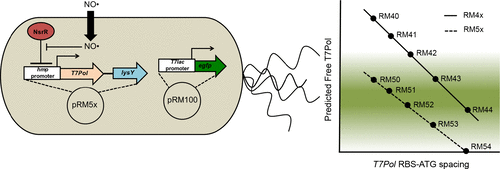当前位置:
X-MOL 学术
›
ACS Synth. Biol.
›
论文详情
Our official English website, www.x-mol.net, welcomes your
feedback! (Note: you will need to create a separate account there.)
Development of Cell-Based Sentinels for Nitric Oxide: Ensuring Marker Expression and Unimodality.
ACS Synthetic Biology ( IF 3.7 ) Pub Date : 2018-07-09 , DOI: 10.1021/acssynbio.8b00146 Ryan McKay 1, 2 , Pricila Hauk 1, 2 , David Quan 1, 2 , William E Bentley 1, 2
ACS Synthetic Biology ( IF 3.7 ) Pub Date : 2018-07-09 , DOI: 10.1021/acssynbio.8b00146 Ryan McKay 1, 2 , Pricila Hauk 1, 2 , David Quan 1, 2 , William E Bentley 1, 2
Affiliation

|
We generated "sentinel" bacteria that respond to the biomarker nitric oxide (NO) and produce a homogeneous and strong fluorescent response. Our dual-plasmid system consists of a signal "relay" vector that employs an NO-responsive promoter that amplifies the native signal (via expression of T7 Polymerase (T7Pol)) to a second vector responsible for GFP expression. Importantly, to achieve an optimal "sentinel" response, we developed strategies that balance the transcriptional load within cells by altering (i) translation and (ii) activity of the T7Pol. Our optimized genetic circuitry was then used to transform commensal E. coli Nissle, as a proof-of-concept toward an ingestible cell-based sensor for Crohn's disease (CD) that, in turn, is marked by elevated levels of intestinal NO. Thus, the "biosensors" demonstrated here may serve as a simple diagnostic tool, contrasting the standard of care including colonoscopies or biopsies.
中文翻译:

基于细胞的一氧化氮哨兵的开发:确保标记表达和单峰性。
我们培育了“哨兵”细菌,它们对生物标志物一氧化氮 (NO) 做出反应,并产生均匀且强烈的荧光反应。我们的双质粒系统由信号“中继”载体组成,该载体采用 NO 响应启动子,将天然信号(通过 T7 聚合酶 (T7Pol) 的表达)放大到负责 GFP 表达的第二个载体。重要的是,为了实现最佳的“哨兵”反应,我们开发了通过改变 T7Pol 的 (i) 翻译和 (ii) 活性来平衡细胞内转录负荷的策略。然后,我们优化的遗传电路被用来改造共生大肠杆菌 Nissle,作为针对克罗恩病 (CD) 的可摄入细胞传感器的概念验证,而克罗恩病 (CD) 的特点是肠道 NO 水平升高。因此,这里展示的“生物传感器”可以作为一种简单的诊断工具,与包括结肠镜检查或活组织检查在内的护理标准形成对比。
更新日期:2018-07-05
中文翻译:

基于细胞的一氧化氮哨兵的开发:确保标记表达和单峰性。
我们培育了“哨兵”细菌,它们对生物标志物一氧化氮 (NO) 做出反应,并产生均匀且强烈的荧光反应。我们的双质粒系统由信号“中继”载体组成,该载体采用 NO 响应启动子,将天然信号(通过 T7 聚合酶 (T7Pol) 的表达)放大到负责 GFP 表达的第二个载体。重要的是,为了实现最佳的“哨兵”反应,我们开发了通过改变 T7Pol 的 (i) 翻译和 (ii) 活性来平衡细胞内转录负荷的策略。然后,我们优化的遗传电路被用来改造共生大肠杆菌 Nissle,作为针对克罗恩病 (CD) 的可摄入细胞传感器的概念验证,而克罗恩病 (CD) 的特点是肠道 NO 水平升高。因此,这里展示的“生物传感器”可以作为一种简单的诊断工具,与包括结肠镜检查或活组织检查在内的护理标准形成对比。











































 京公网安备 11010802027423号
京公网安备 11010802027423号